2020
Airbus SA in Toulouse heeft een voormalig directeur van General Electric Co. gekozen tot de nieuwe verkoopleider van de vliegtuigbouwer in Europa in een poging om haar verkoopapparaat te versterken om door de pandemie heen te komen.
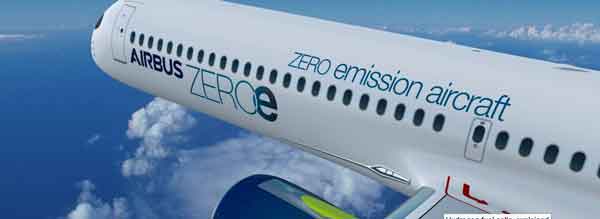
Het bedrijf bevestigde dat Wouter van Wersch, die tot vorige maand GE’s voorzitter en chief executive officer voor Azië-Pacific was, de rol op zich zal nemen. Hij zal op 1 september beginnen.
Van Wersch zal met het bijsturen van Airbus door de luchtvaartcrisis worden belast die door de Covid-19 uitbarsting wordt veroorzaakt terwijl het streven om het effect van lagere vliegtuigenverkoop en productie te minimaliseren. Hij zal ook verantwoordelijk zijn voor het beheer van de relaties met belangrijke klanten zoals Air France-KLM, EasyJet Plc en Deutsche Lufthansa AG.
De benoeming komt op een uitdagend moment voor Airbus, ook al is het bedrijf er grotendeels in geslaagd om annuleringen van orders die aan het virus zijn verbonden te voorkomen. Het openhouden van de communicatielijnen met klanten die nog steeds te maken hebben met reisquarantaines zal van vitaal belang zijn.
Europa’s grootste discountmaatschappij, Ryanair Holdings Plc, zei maandag het aantal vluchten voor september en oktober te verlagen nadat de vraag van potentiële vakantiegangers was afgenomen. Andere luchtvaartmaatschappijen zouden vergelijkbare bezuinigingen doorvoeren na een Europese golf van nieuwe virusgevallen. Volgens zijn LinkedIn-profiel werkte Wouter van Wersch eerder met Airbus als salesmanager voor Matra Communication. De rol duurde bijna drie jaar, te beginnen in 1997. Hij heeft ook functies bekleed bij Alcatel Lucent SAS en Alstom SA. Hij werkte bijna vijf jaar bij GE na de overname van de elektriciteits- en netwerkeenheid van Alstom.
2017
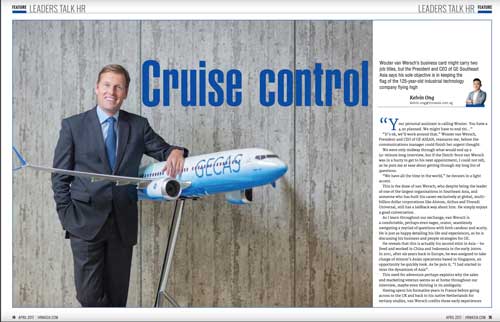 Wouter van Wersch’s business card might carry two job titles, but the President and CEO of GE Southeast Asia says his sole objective is in keeping the flag of the 125-year-old industrial technology company flying high.
Wouter van Wersch’s business card might carry two job titles, but the President and CEO of GE Southeast Asia says his sole objective is in keeping the flag of the 125-year-old industrial technology company flying high.
“Your personal assistant is calling Wouter. You have a 4.30 planned. We might have to end this.”
“It’s ok, we’ll work around that,” Wouter van Wersch, President and CEO of GE ASEAN, reassures me, before the communications manager could finish her urgent thought.
We were only midway through what would end up a 52-minute long interview, but if the Dutch-born van Wersch was in a hurry to get to his next appointment, I could not tell, as he puts me at ease about getting through my long list of questions.
“We have all the time in the world,” he iterates in a light accent.
This is the draw of van Wersch, who despite being the leader of one of the largest organizations in Southeast Asia, and someone who has built his career exclusively at global, multi-billion dollar corporations like Alstom, Airbus and Vivendi Universal, still has a laidback way about him. He simply enjoys a good conversation.
As I learn throughout our exchange, van Wersch is a comfortable, perhaps even eager, orator, seamlessly navigating a myriad of questions with both candour and acuity. He is just as happy detailing his life and experiences, as he is discussing his business and people strategies for GE.
He reveals that this is actually his second stint in Asia – he lived and worked in China and Indonesia in the early 2000s. In 2011, after six years back in Europe, he was assigned to take charge of Alstom’s Asian operations based in Singapore, an opportunity he quickly took. As he puts it, “l had started to miss the dynamism of Asia”.
This need for adventure perhaps explains why the sales and marketing veteran seems so at home throughout our interview, maybe even thriving in its ambiguity.
Having spent his formative years in France before going across to the UK and back to his native Netherlands for tertiary studies, van Wersch credits these early experiences for his ability to transition smoothly into different jobs and environments.
“It’s not about people adapting to me, I am the one who has to adapt to them and their culture,” he says.
Now sitting at the helm of GE Southeast Asia, this flexibility has allowed van Wersch to embrace the biggest job of his life thus far. He has big plans for the region (“I want to define where GE will be in Southeast Asia in 2025”), but believes his most important task is to ensure an 10,000 employees across the region work well together towards the same goals.
That’s because at his core, van Wersch maintains that he is a team player with a keen interest to not only “support” his people, but also “challenge” them.
“I don’t like people who think they are the best, or have a big ego. It’s always a team effort,” he remarks.
Indeed, van Wersch is the first to admit a leader is only as good as the people around them. “l have a great support system here, without whom I would not be able to do my job well,” he says.
And as a team player, van Wersch loves having open, honest dialogues with employees on an organisation-wide feedback app called Performance Development @ GE.
GE, which operates eight business units including oil and gas, power, transportation and aviation, in a historic move last year eliminated all semblance of farmer CEO Jack Welch’s infamous “rank-and-yank” style of performance ratings.
Constant feedback and conversations are now favoured over the practice of automatically culling the bottom 10% of the workforce each year.
“The world today is not the same one as when Jack Welch was heading the company,” van Wersch clarifies, adding that the new performance management tools show the organisation is changing with the times.
As the communications manager signaIs to me to wrap up the interview, I ask van Wersch how he would rate his performance at GE up to this point. He laughs at the question, but almost immediately goes into deep thought.
“On a scale of one to 10, I would give myself an eight,” he pauses. “No erase that, maybe a seven.” Either way, he admits there is still room to grow in the years ahead.
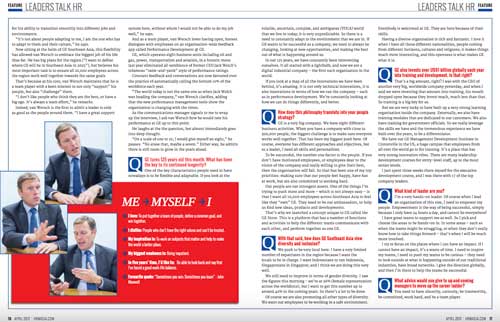 GE turns 125 years old this month. What has been the key to its continued longevity?
GE turns 125 years old this month. What has been the key to its continued longevity?
One of the key characteristics people need to have nowadays is to be flexible and adaptable. If you look at the volatile, uncertain, complex, and ambiguous (VUCA) world that we live in today; it is very unpredictable. So there is a need to constantly adapt to the environment that we are in. If GE wants to be successful as a company, we need to always be changing, looking at new opportunities, and making the best out of what is happening around us.
In our 125 years, we have constantly been reinventing ourselves. It all started with a lightbulb, and now we are a digital industrial company – the first such organisation in the world.
If you look at a map of all the innovations we have been behind, it’s amazing. It’s not only technical innovations, it is also innovations in terms of how we run the company – such as in performance development. We’re constantly looking at how we can do things differently, and better.
How does this philosophy translate into your people strategy?
GE is a very big company. We have eight different business activities. When you have a company with close to 300,000 people, the biggest challenge is to make sure everyone works well together. That has been my biggest push here. Of course, everyone has different approaches and objectives, but as a leader, l need all skills and personalities.
To be successful, the number one factor is the people. If you don ’t have motivated employees, or employees dear to the vision of the company and really hilling to give their best, then the organisation will fail. So that has been one of my top priorities: making sure that our people feel happy, have fun at work, but are also committed to working hard.
Our people are our strongest assets. One of the things I’m trying to push more and more – which is not always easy – is that I want all 10,000 employees across Southeast Asia to feel like they “own” GE. They need to be our ambassadors, to help us find new ideas, products and developments.
That’s why we launched a concept unique to GE called the GE Store. This is a platform that has a number of functions and activities to help the different teams communicate with each other, and perform together as one GE.
With that said, how does GE Southeast Asia view diversity and inclusion?
We push to be very local here. I have a very limited number of expatriates in the region because I want the locals to be in charge. I want Indonesians to run Indonesia, Singaporeans in Singapore; and I think we are doing this very well.
We still need to improve in terms of gender diversity. I saw the figures this morning – we’re at 26% (female representation across the workforce), but I want to get this number up to around 40% in the coming years. So there’s a lot to be done.
Of course we are also promoting all other types of diversity. We want our employees to be working in a safe environment.
Everybody is welcomed at GE. They are here skills.
Having a diverse organisation is rich and fantastic. I love it when I have all these different nationalities, from different horizons, cultures and religions; it makes things much more interesting, and this openness is what makes GE what it is.
GE also invests over US$ 1 billion each year into training and development. Is that right?
That’s a big amount, right? I was with the CEO of another very big, worldwide company yesterday and when I said we were investing that amount into training, his mouth dropped open because they invest much, much less than that. So training is a big key for us.
But we are very lucky to have built up a very strong learning organisation inside the company. Externally, we also have training modules that are dedicated to our customers. We also have training for government officials. So we really leverage the skills we have and the tremendous experience built over the years, to be a differentiator.
We have our GE Management Development Institute in Crotonville in the US, a huge campus that employees all over the world go to for training. It’s a place that has very strong innovation vibes. There are many leadership development courses for entry-level staff, up to the most senior levels.
I just spent three weeks there myself for the executive development course, and I was there with 17 of the top company leaders.
What kind of leader are you?
I’m very hands-on leader. Of course when I lead an organisation of this size, I need to empower my people. Empowerment is the way of being successful, simply because I only have 24 hours a day, and cannot be everywhere.
I have great teams to support me as well. So I pick and choose the areas to be hands-on in. In some areas – such as when the teams might be struggling, or when they don’t really know how to take things forward – that’s when I will be much more involved.
I try to focus on the places where I can have an impact. If I cannot have an impact, it’s a waste of time. I need to inspire my teams, l need to push my teams to be curious – they need to look outside at what is happening outside of our traditional industries, have broad networks. I give the direction globally and then I’m there to help the teams be successful.
What advice would you give to up-and-coming manager to move up the career ladder?
You need to have sincerity curiosity, be trustworthy, be committed, work hard, and be a team player.
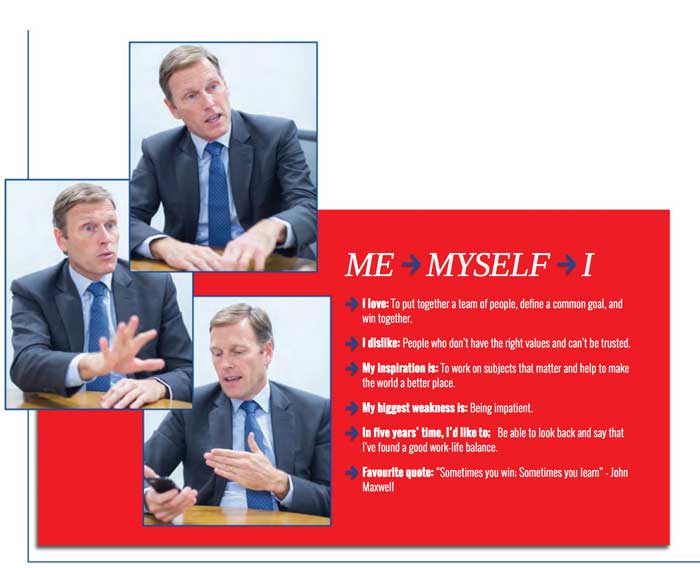
Me → myself → I
- I love: To put together a team of people, define a common goal, and win together.
- I dislike: People who don’t have the right values and can’t be trusted.
- My inspiration is: To work on subjects that matter and help to make the world a better place.
- My biggest weakness is: Being impatient.
- In five years’ time, I’d like to: Be able to look back and say that I’ve found a good work-life balance.
- Favourite quote: “Sometimes you win, Sometimes you learn,” -John Maxwell.
bron: HRM Magazine Asia April 2017
2016
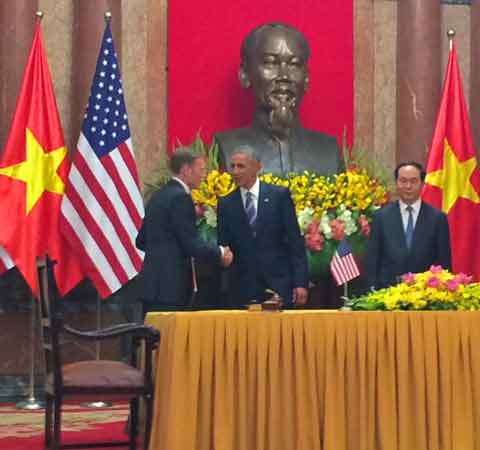
Op 23 mei 2016 tekende Wouter van Wersch als president en Chief Executive Officer van General Electric over Azië een handelsovereenkomst met de Minister van Industrie en Handel van Vietnam om een groot aantal windboerderijen te gaan bouwen die in 2015 1000 megawatt aan windenergie aan Vietnam gaan leveren. Hierbij aanwezig waren de presidenten van Amerika en van Vietnam.
Onderschrift bij het artikel:
President Obama with president Tran Dai Quang of Vietnam at the presidential palace in Hanoi, Vietnam. Vietnam had repeatedly asked for the decades-long ban to be removed.
Nu hebben verschillende Stamgenoten koninginnen en koningen een hand gegeven, maar nog nooit heeft een Stamgenoot de Amerikaanse president een hand gegeven. Wouter was de eerste.
foto: Doug Mills
2015
Wouter van Wersch, 47, is President & CEO of GE ASEAN, based in Singapore. He has worked in a number of large multinational companies and has more than 20 years of international leadership experience in marketing, sales and general management. Of his entire career, he has spent more than 13 years embracing market dynamics and successfully growing businesses in ASEAN.
He started his career in 1994 at Vivendi Universal’s international marketing department in Paris, before moving to Airbus as Sales Manager Asia. In 2000, he joined Alcatel where he was successively Business Development Director Europe, Sales Director Asia Pacific based in Shanghai, and General Manager Indonesia based in Jakarta.
Wouter joined Alstom in 2006 as Vice President Sales for Europe and was promoted in 2011 to Senior Vice President Asia Pacific based in Singapore. In 2014 he became the Growth Leader in the GE-Alstom integration team and was appointed President & CEO of GE ASEAN when the acquisition was completed in 2015.
A native of the Netherlands, Wouter grew up in France, and is a graduate in Business Administration from the Erasmus University Rotterdam. Wouter and his wife Lorraine have three children aged 15, 13 and 8. He is an enthusiastic sportsman, especially field hockey, which he played at the highest international level
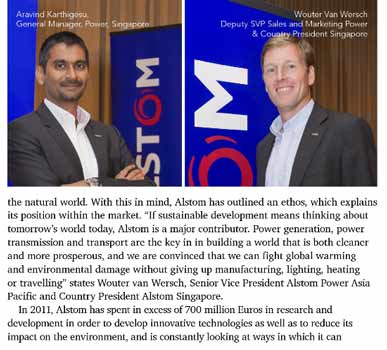 2012
2012
In 2012 is Wouter van Wersch (op de rechterfoto) senior vice president Alstom Power Asia, Pacific en president van Alstom Singapore.
bron: Business Review Australia. maart 2012
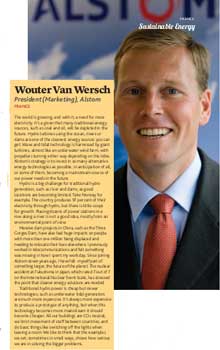 Wouter van Wersch
Wouter van Wersch
President (Marketing), Alstom France
The world is growing, and with it, a need for more electricity. It’s a given that many traditional energy sources, such as coal and oil, will be depleted in the future. Hydro turbines using the ocean, rivers or dams are one of the cleanest energy sources you can get. Wave and tidal technology is harnessed by giant turbines, almost like an underwater wind farm, with propellers turning either way depending on the tides.
Alstom’s strategy is to invest in as many alternative energy technologies as possible, in anticipation of all, or some of them, becoming a mainstream source of our power needs in the future.
Hydro is a big challenge for traditional hydro generation, such as river and dams, as good locations are becoming limited. Take Norway for example. The country produces 97 percent of their electricity through hydro, but there is little scope for growth. Placing dozens of power stations in a row along a river is not a good idea, mostly from an environmental point of view.
Massive dam projects in china, such as the Three Gorges Dam, have also had huge impacts on people, with more than one million being displaced and needing to relocate their lives elsewhere.
I previously worked in telecommunications and felt something was missing in how I spent my work day. Since joining Alstom seven years ago, I have felt myself part of something larger, the future of the planet. The nuclear accident at Fukushima in Japan, which rated 7 out of 7 on the international nuclear event scale, has stressed the point that cleaner energy solutions are needed.
Traditional hydro power is cheap but newer technologies, such as underwater tidal generators are much more expensive. It’s always more expensive to produce a prototype of anything, but when this technology becomes more mainstream it should become cheaper. All our buildings are CO2 neutral, we limit movement of staff between countries, and do basic things like switching off the lights when leaving a room. We like to think that the examples we set, sometimes in small ways, shows how serious we are in solving the bigger problems.
Vertaling
De wereld groeit, en daarmee de behoefte aan meer elektriciteit. Het is een gegeven dat veel traditionele energiebronnen, zoals kolen en olie, in de toekomst uitgeput zullen zijn. Waterkracht turbines die gebruik maken van de oceaan, rivieren of dammen zijn een van de schoonste energiebronnen die je kunt krijgen. Golf- en getijdenenergie technologie wordt benut door reusachtige turbines, het lijkt wel een onderwater windpark, met propellers die beide richtingen kunnen draaien, afhankelijk van de getijden.
Alstom ’s strategie is het om in zoveel mogelijk alternatieve energietechnologieën te investeren in afwachting dat alle, of sommige van hen, de hoofdbron worden voor onze energieleveringen in de toekomst.
Hydro is een grote uitdaging voor de traditionele hydro generatie, als de rivier en dammen, want goede locaties zijn moeilijker te vinden. Neem bijvoorbeeld Noorwegen. Het land produceert 97 procent van hun elektriciteit door middel van waterkracht, maar er is weinig ruimte voor groei. Het plaatsen van tientallen centrales in een rij langs een rivier is geen goed idee, vooral vanuit milieu-oogpunt. Grootse dam projecten in China, zoals de Drie Bronnen Dam, hebben ook grote gevolgen voor de mens, meer dan een miljoen zijn ontheemd en dienen hun leven ergens anders weer op te bouwen.
Ik werkte eerder in de telecommunicatie en voelde dat er iets ontbrak in de manier waarop ik mijn werk dag doorbracht. Vanaf het moment dat ik zeven jaar geleden toetrad tot Alstom, voelde ik mij onderdeel van iets groters, de toekomst van de planeet. Het nucleaire ongeluk in Fukushima in Japan, die een 7 scoorde op de lijst van 7 op de Internationale Nuclear Event Scale, zorgde er bij mij voor dat schonere energie oplossingen nodig zijn.
Traditionele waterkracht is goedkoop. Nieuwere technologieën, zoals onder water getijde-generatoren, zijn veel duurder. Het is altijd duurder een prototype van iets te produceren. Wanneer deze technologie meer mainstream wordt, wordt het ook goedkoper. Al onze gebouwen zijn CO2-neutraal, we beperken het reizen van personeel tussen landen en we doe elementaire zaken zoals het licht uit doen wanneer we een ruimte verlaten. We willen graag denken dat de voorbeelden die we stellen, soms in kleine dingen, laat zien hoe serieus we zijn in het oplossen van de grotere problemen.
bron: Real Leaders Issue 3 Final Energy Story
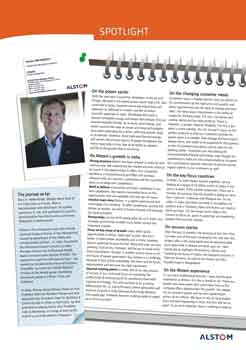 The journey so far
The journey so far
Bom in Netherlands, Wouter spent most of his initial years in France. After a baccalaureate with distinction, he studied economics in UK and graduated in business administration from the Erasmus University in Rotterdam.
Wouters first assignment was with Vivendi Universal Group in France in the international marketing department of the media and communication division. In 1997, he entered the telecommunication industry as Sales Manager Asia for the Professional Mobile Radio Communication division of EADS. The experience made him shift base to Asia… the market he considered the future of business. Thereafter, he joined the Mobile Network Division of the Alcatelgroup, developing
Businesses based in France, China and Indonesia.
In 2006, Wouter joined Alstom Power as Vice President Sales for Northern Europe and was appointed Vice President Sales for Northern & Central Europe in 2009. In April 2011, he was promoted to Deputy Senior Vice President Sales &Marketing, in charge of Asia Pacific and he is currently based in Singapore.
De reis tot nu toe
Wouter werd in Nederland geboren en bracht het grootste deel van het begin van zijn carrière door in Frankrijk. Na een baccalaureaat met onderscheiding, studeerde studeerde economie in het Verenigd Koninkrijk en studeerde in het Business Administration aan de Erasmus Universiteit in Rotterdam.
Wouters eerste baan was bij de Vivendi Universal groep in Frankrijk op de internationale marketing-afdeling van de media en communicatie divisie. In 1997was hij werkzaam als Sales Manager Azië in de telecombranche voor de professionele mobiele radiocommunicatie divisie van EADS. Hierdoor moest hij naar Azië verhuizen; de markt die hij als de toekomst van het bedrijfsleven beschouwt. Daarna trad hij toe tot de Mobile Network Division van de Alcatelgroup, waar hij bedrijven vestigde in Frankrijk, China en Indonesië.
In 2006 trad Wouter toe als Vice President Sales voor Noord-Europa bij Alstom Power en werd benoemd tot Vice President Sales voor Noord-& Midden-Europa in 2009. In april 2011 werd hij gepromoveerd tot Deputy Senior Vice President Sales & Marketing, verantwoordelijk voor Azië-Pacific en is momenteel gevestigd in Singapore.
bron: Spotlight, personeelsuitgave Alstom
2007
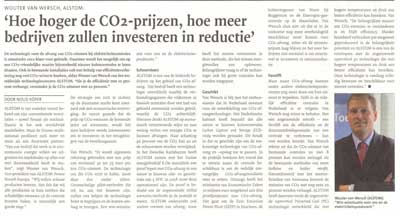 WOUTER VAN WERSCH, ALSTOM
WOUTER VAN WERSCH, ALSTOM
“Hoe hoger de C02-prijzen, hoe meer bedrijven zullen investeren in reductie.”
De technologie voor de afvang van CO2-uitstoot bij elektriciteitscentrales is omstreeks 2012 klaar voor gebruik. Daarmee wordt het mogelijk om op een CO2-vriendelijke manier bijvoorbeeld nieuwe kolencentrales te laten draaien. Ook in bestaande installaties valt met behulp van efficientieverbetering nog veel CO2-winst te boeken, aldus Wouter van Wersch van het wereldwijde technologieconcern Alstom. “Als je de efficiëntie met 10 procent verhoogt, verminder je de CO2-uitstoot met 20 procent.”
DOOR NOUD KOPER
Alstom is van oudsher vooral bekend om zijn conventionele installaties – zowel fossiel als nucleair. Daarin is het ook wereldwijd marktleider. Maar de Franse multinational profileert zich meer en meer als een duurzame partner.” Van een bedrijf dat sterk is in conventionele energie willen we uitgroeien tot marktleider op alles wat met duurzaamheid heeft te maken”, zegt Wouter van Wersch vice-president van Alstom Power Noord-Europa, “Wij willen schone producten leveren. Het feit dat wij alle producten in huis hebben die schadelijke emissies uit de centrale kunnen halen, is natuurlijk een goede stap.”
De strategie om zich te richten op de duurzame markt kent uiteraard ook een economische overweging. Er vanuit gaande dat de prijs op CO2-emissies in de komende jaren zal toenemen, wordt het voor bedrijven steeds interessanter om te investeren in het terugdringen van de broeikasgassen.
Van Wersch: “Er wordt algemeen rekening gehouden met een prijs van minimaal 30 tot 35 euro per ton CO2-uitstoot. De technologie om die CO2 eruit te halen, moet daar dus onder zitten. Grootschalige pilot-eenheden die wij nu laten bouwen zijn, zullen ons helpen de technologie beter te begrijpen en de kosten omlaag te brengen. Een win-winsituatie voor ons en de elektriciteits-producent.”
Schoorsteen
Alstom is een van de leidende bedrijven op het gebied van CO2-afvang . Het bedrijf heeft een technologie ontwikkeld waarbij de verbrandingsgassen die vrijkomen in fossiele centrales door een bad van gekoeld ammoniak worden geleid, waarbij de CO2 achterblijft. Hiermee denkt Alstom op economisch verantwoorde wijze en met weinig verlies van energie CO2 te kunnen afvangen. Naar schatting 90 procent van de CO2 kan zo uit de schoorsteen worden verwijderd. In het Zweedse Karlshamm heeft ALSTOM samen met het Duitse energiebedrijf E-On inmiddels een proef lopen met CO2-afvang in een nieuw te bouwen olie- en gascentrale van 5 MW. In 2008 moet deze operationeel zijn. De proef is bedoeld om de zogenoemde chilled ammonia methode in de praktijk te testen. ALSTOM onderzoekt ook andere vormen van afvang, maar heeft het meeste vertrouwen in deze methode die het minste energieverlies zou opleveren. Belangrijkste vraag is of de technologie ook bij grote centrales kan worden toegepast
Geschikt
Van Wersch is blij met het enthousiasme dat in Nederland ontstaat voor de ontwikkeling van CO2-afvangtechnologie. Het Nederlandse kabinet heeft bepaald dat alle nieuw te bouwen kolencentrales Carbon Capture and Storage (CCS) ready worden gemaakt. Dit houdt in dat ze geschikt zijn om de toekomstige technologie van CO2-afvang en -opslag toe te passen. In de praktijk betekent het vooral dat er terrein naast de centrale beschikbaar is om de redelijke omvangrijke CO2-afvanginstallatie neer te zetten. Onlangs heeft het Ministerie van Economische Zaken 10 miljoen euro toegekend aan drie proefprojecten met CO2-afvang. Het gaat om de Zero Emission Power Plant (ZEPP) in Drachten, de kolenvergasser van Nuon bij Buggenum en de Enecogen-gascentrale op de Maasvlakte. Wouter van Wersch sluit niet uit dat in de toekomst nog meer overheidsgeld beschikbaar moet komen voor CO2-afvang zeker als de emissie-prijzen laag blijven en het voor bedrijven niet rendabel is van structureel te investeren in emissiereductie.
Facelift
Maar naast CO2-afvang kunnen onder andere elektriciteitsproducenten nog meer doen om hun uitstoot te beperken. Zelfs in de redelijk efficiënte centrales in Nederland is er volgens Van Wersch nog winst te behalen. Met een zogenaamde retrofit – een facelift om de efficiëntie en de duurzaamheidsprestatie van een centrale te verbeteren – kan veel worden bereikt. Van Wersch rekent uit dat de CO2-uitstoot van bestaande centrales zo met 8 procent kan worden verlaagd via de bestaande methodes van steam turbine en boiler retrofit. Gecombineerd met het mee verbranden van biomassa kunnen de emissies van CO2 met nog eens 20 procent worden verlaagd. Alstom heeft daarvoor mede de zogenoemde supercritical Pulvarised Coal (PC) technologie ontwikkeld die met hogere temperaturen en druk een betere efficiëntie kan bereiken.Wouter van Wersch: “De belangrijkste manier om CO2 emissies te verminderen is en blijft efficiency. Minder brandstof verbruiken per megawatt geproduceerd is de belangrijkste prioriteit en ALSTOM is een van de voorlopers met de zogenoemde supercritical pc technologie die met hogere temperaturen en druk een betere efficiëntie kan bereiken. Deze technologie is vandaag volledig bewezen en beschikbaar voor nieuwe centrales.
bron: Energie Nederland, nov. 2007
Klik hier voor Wouter van Wersch in de Kerkraadse Tak.

